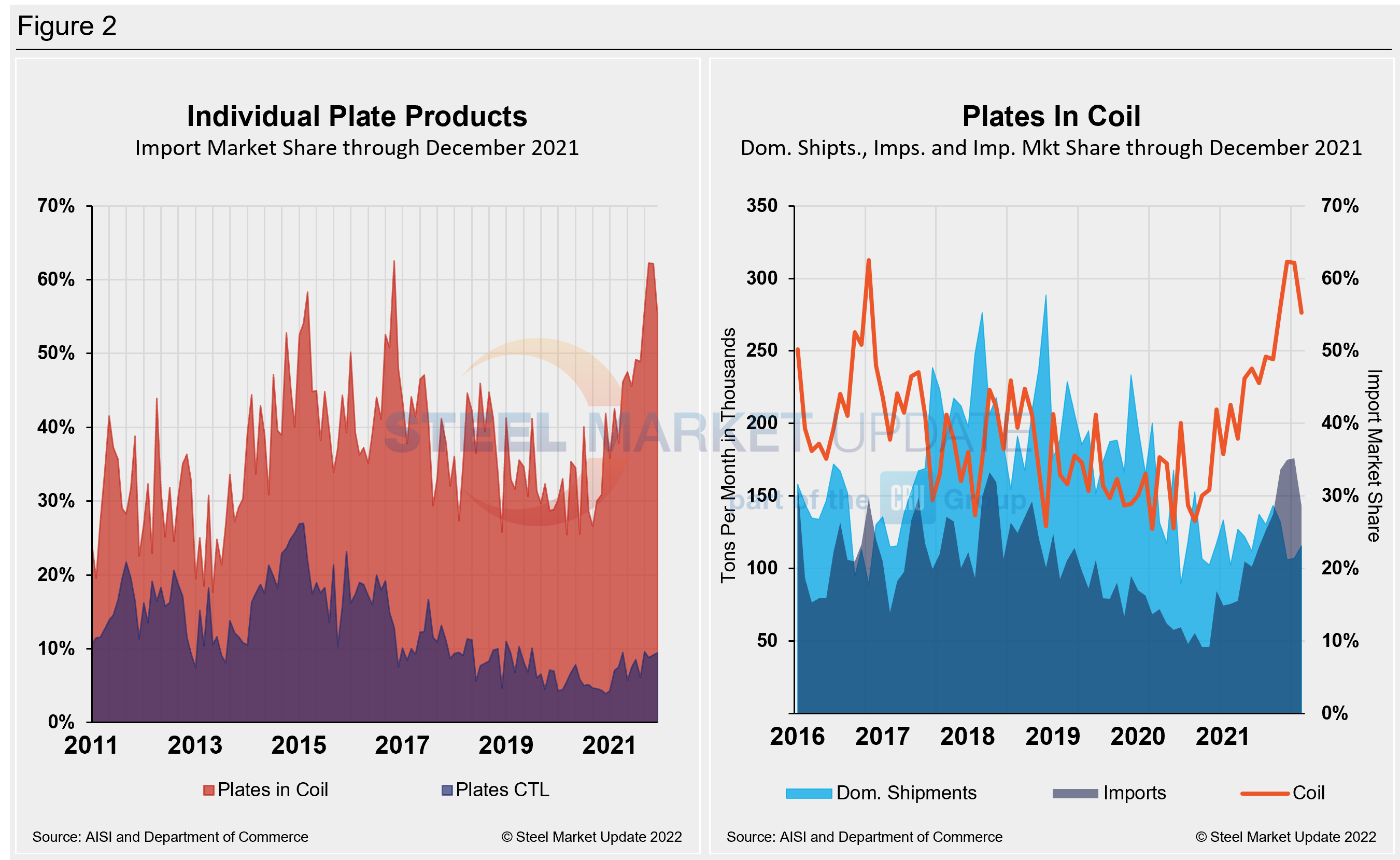Plate

February 15, 2022
Imports' Share of U.S. Sheet and Plate Markets Slips in December
Written by David Schollaert
Imports of less-expensive sheet and plate products continued to arrive on U.S. shores at the end of 2021, but at a slower pace. December marked the first decrease in overall flat product imports in eight months, according to Commerce Department data.
Driven by the need for buyers to find relief from inflated steel prices in the U.S., imports’ shares of the U.S. sheet and plate products markets in November reached their highest levels in the past 4-5 years. As the market slowed at the year end, so did imports.
Imports’ share of total sheet product shipments into the U.S. was 18.7% in December, a decrease from 21.5% the month prior. The decrease was driven by a 16.1% decline in foreign sheet, while domestic shipments of sheet products slipped just fractionally by 0.6% month on month. Market share of plate product imports also fell in December to 26.4% from 28.6% the month prior.
December’s sheet products imports totaled 983,592 tons, down from 1.179 million tons in November and dropping below the 1-million-ton mark for the first time since last August.
Overall sheet product shipments (domestic shipments plus imports) were down 4.0% in December versus November, totaling 5.272 million tons and driven by a decrease of nearly 200,000 tons of foreign shipments. Hot rolled coil (HRC) imports totaled 287,819 tons in December, down a whopping 35.3% versus the month prior, and pushing import market share down 6.1 percentage points to 14.2%. These details are shown below in Figure 1.

Plate products in December saw an overall decrease in shipments as apparent supply slipped by 9.8% month on month. The loss was driven by a decline of 16.6% in imports and 7.0% in domestic plate shipments. December plate imports of 184,226 tons represented just the fifth highest total all year, a letdown from November which was strongest showing since May 2018. All told, total plate shipments downstream, including foreign and domestic, were 697,116 tons in December, down from 772,441 tons the month prior.
The import share of HRC fell 6.1 percentage points to 14.2% in December, the lowest mark since July. The drop in share was driven by a 35.3% decrease in foreign material, while domestic shipments slipped just 0.2% month on month. HRC imports totaled 287,819 tons, dropping below the 300,000-ton mark for the first time in six months.
Imports of cold rolled coil (CRC) and other metallic coat (OMC) were both down in December. However, CRC’s drop was far more significant, down 26.0% month on month, versus a 13.7% decline for OMC. The share of foreign CRC and OMC both slipped to 14.7% and 26.9%, respectively. Galvanized (hot dipped and electrolytic) imports slipped just 1.9% in December to 312,954 tons or an 18.8% market share. The figure was just a 0.2 percentage point decrease month on month from 19.0% in November.
The import market share for plates in coil fell to 55.3% in December, a 6.9 percentage point declne month on month. The decrease was driven by an 18.7% decrease in total imports in December, while domestic shipments rose 8.0% over the same period. Total imports of plates in coil were 142,953 tons in December, down from November’s 175,817 tons – the highest mark since July 2015. The shift in December brought total supply down 9.8% month on month to 258,442 tons.
The table below displays total supply to the market in three months and 12 months through December 2021 for sheet and plate products and six subcategories. Supply to the market is the total of domestic mill shipments plus imports. It shows imports on the same three- and 12-month basis and then calculates import market share for the two time periods for six products. Finally, it subtracts the 12-month share from the three-month share and color codes the result green or red according to gains or losses. If the result of the subtraction is positive, it means that import share is increasing, and the code is red.

The big picture is that imports’ share of U.S. sheet and plate sales, although down, remain high, and in some cases just near all-time highs. The big second-half jump in total imports was the result of historically and disproportionately high domestic steel prices. December’s decline coincides with eroding U.S. domestic steel prices, yet they remain at a premium to foreign material, thus elevated import totals should continue for the time being.
Hot rolled and cold rolled sheet and strip have seen a trend shift along with plate products, illustrating how import competition is impacting domestic products in three months compared to 12 months. Most notable of those subcategories are plates in coil (up 10.5%) and hot rolled coil (up 4.7%) through December 2021.
The import market share of individual plate products as well as a breakdown of the market share for plates in coil are displayed together in Figure 2. The historical import market share of plate and sheet products and the import market share of the four major sheet products are shown side-by-side in Figure 3.


By David Schollaert, David@SteelMarketUpdate.com






